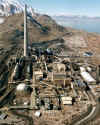|
||
| Sulphuric Acid on the WebTM | Technical Manual | DKL Engineering, Inc. |
Knowledge for the
Sulphuric Acid Industry
![]()
Sulphuric Acid on the Web
Introduction
General
Equipment Suppliers
Contractor
Instrumentation
Industry News
Maintenance
Acid
Traders
Organizations
Fabricators
Conferences
Used
Plants
Intellectual
Propoerty
Acid
Plant Database
Market
Information
Library
Technical Manual
Introduction
General
Definitions
Instrumentation
Plant Safety
Metallurgial
Processes
Metallurgical
Sulphur Burning
Acid Regeneration
Lead Chamber
Technology
Gas Cleaning
Contact
Strong Acid
Acid Storage
Loading/Unloading
Transportation
Sulphur
Systems
Liquid SO2
Boiler Feed Water
Steam Systems
Cooling Water
Effluent Treatment
Utilities
Construction
Maintenance
Inspection
Analytical Procedures
Materials of Construction
Corrosion
Properties
Vendor Data
DKL Engineering, Inc.
Handbook of Sulphuric Acid Manufacturing
Order
Form
Preface
Contents
Feedback
Sulphuric Acid
Decolourization
Order Form
Preface
Table of Contents
Process Engineering Data Sheets - PEDS
Order
Form
Table of Contents
Introduction
Bibliography of Sulphuric Acid Technology
Order Form
Preface
Contents
Acid Plant Database January 15, 2021
| Owner | Rio Tinto Kennecott Utah Copper Corporation |

|
||
| Location |
Smelter & Refinery 12000 West 2100 South Magna, Utah USA 84044 |
|||
| Background | Parent
company is Rio Tinto 1903
- Original Utah Copper Company was created to mine and process low grade
copper ore found in a mountain in Bingham Canyon, about 25 miles southwest
of Salt Lake City. |
|||
| Website | www.riotintokennecott.com | |||
| Plant | - | |||
| Coordinates | 40º 43' 24" N, 112º 11' 46" W | |||
| Type of Plant | Metallurgical | |||
| Gas Source |
Copper
Outotec (Outokumpu) Flash Furnace and Flash Converting (1995) - replaces Noranda Reactor |
|||
| Plant Capacity | 3500 MTPD | |||
| SA/DA | 3/1 DA | |||
| Emissions |
SO2: < 100 ppm (annual average) < 170 ppm (24 hour calendar day average) < 250 ppm (6 hour block average) Acid Mist: < 0.67 mg/SCF Opacity: < 15% |
|||
| Status | Operating | |||
| Year Built | 1995 | |||
| Technology | MECS | |||
| Contractor | MECS | |||
| Remarks |
The
smelter -- the cleanest in the world -- captures 99.9% of the sulfur dioxide
emissions produced. Once the sulfur dioxide gas is cleaned, it is piped to
the acid plant, which converts the sulfur dioxide to sulfuric acid. In this
way, our acid plant acts as a huge pollution control device that also
produces a high-quality commercial product.
Feed Gas: 14% SO2 (dry gas), O2:SO2
ratio = 0.986 The old smelter was constructed in the late 1970’s and included a complex material handling system, three (3) Noranda Reactors, four (4) Peirce-Smith converters and a three (3) furnace anode casting plant. In 1987 environmental constraints limited the operation to one (1) Noranda reactor with three (3) hot Peirce-Smith Converters, but only two vessels could operate (blow) at once. Concentrate smelting capacity was about 500,000 tonnes per year. Process gas from the one (1) operating reactor and one (1) converter, about 290,000 Nm3/h, was treated in two (2) single contact sulphuric acid plants. |
|||
| Permits |
State of Utah Department of Environmental Quality Facility ID: 10346 Title V Operating Permit |
|||
| Permit No. | Issue Date | Expiry Date | Details | |
| 3500030002 | July 9, 2007 | - | - | |
| - | - | - | - | |
| Pictures |  
 |
|||
| General | As the second largest copper producer in the United States, Kennecott Utah Copper produces over 17% of America's copper output. That copper comes from the Bingham Canyon Mine, the worlds first and largest open pit copper mine, located about 28 miles southwest of Salt Lake City, Utah. Every year, Kennecott produces about 300,000 tons of copper cathode-- along with 400,000 ounces of gold, 4 million ounces of silver, about 24 million pounds of molybdenum, and about 1 million tons of sulfuric acid, a by-product of the smelting process, which is used in farming and industry. | |||
| References | - | |||
| News |
April 6, 2020 - Rio Tinto has
enforced a force majeure on copper cathode contracts for the Kennecott mine
in Utah, the United States, after an earthquake last month caused an
emergency shutdown at the smelter.Force majeure is a contractual clause
which absolves the relevant parties from honouring the terms of the contract
due to an extraordinary event or circumstance beyond their control.
Rio Tinto stated that it had decided to declare force majeure on Kennecott
shipments after a 5.7-magnitude earthquake impacted the operations on March
18. “We are working to restart Kennecott’s smelter after the emergency
shutdown in response to the earthquake and working with our customers to
minimise any disruption in supply,” a Rio Tinto spokesperson said. Rio
Tinto produced 186,800 tonnes of copper at the Kennecott smelter near Salt
Lake City last year, which also produces gold and silver as byproducts from
its operations. In December, Rio Tinto announced its plan to invest
$1.5 billion to expand the Kennecott operation and extend its life of mine
through to 2032. January 26, 2018 - Rio Tinto lifted force majeure on Jan. 1 for shipments of refined copper and acid from its Kennecott mine in the United States, 79 days after declaring it could not meet customer commitments, a spokesman said on Friday. The global miner declared force majeure October 13, after halting production of refined copper at its Utah mine smelter following the death of a worker exposed to sulfur dioxide gases at the plant. It restarted the smelter November 17. “It’s business as usual,” said spokesman Kyle Bennett. In the fourth quarter, refined copper production at Kennecott declined 67 percent compared with the same period in the previous year, to 22,100 tonnes from 67,000 tonnes, Rio said in an operations report last week. The smelter was expected to draw down an increased concentrate inventory during the first half of 2018, Rio said. In 2017, Kennecott produced 125,800 tonnes of refined copper, down some 20 percent from 2016. October 17, 2017 - Global miner Rio Tinto declared force majeure last Friday on shipments of refined copper from its Kennecott mine in the United States following the death of a worker, a spokesman said on Tuesday. There was no timeline for when the force majeure would be lifted, spokesman Kyle Bennett said. A force majeure is usually implemented by companies during unforeseen events. Rio Tinto halted production of refined copper at its smelter at the Utah-based mine on Oct. 8 after a worker was exposed to sulfur dioxide gases at the plant while removing debris from a boiler. The worker died two days later. Rio Tinto Kennecott comprises nearly 20 percent of U.S. copper production, Bennett said. The unit produced 156,500 tonnes of refined copper in 2016, about 63 percent of group output. Rio Tinto has also declared force majeure on acid deliveries from the smelter, Bennett said. October 11, 2017 - A Kennecott employee exposed to sulfur dioxide over the weekend has died, company officials said.Albert Lozano, 64, was working at Rio Tinto Kennecott's smelter Sunday, performing regular duties to remove debris from a boiler, when he was exposed to the toxic gas, said Rio Tinto Kennecott spokesman Kyle Bennett.Lozano had been with the company for 12 years, Bennett said."Right now, we don't know exactly how the exposure took place," he said.A boiler is used as part of the smeltering process, Bennett explained, and every once in a while, particulate matter needs to be cleaned out of it.Lozano was treated at the scene before being taken to a local hospital, where he died Tuesday night, Bennett said."This is devastating news to our business. We pride ourselves on safety. So when something like this happens, it really shakes us to our core," he said.The entire Rio Tinto Kennecott plant shut down for an hour Wednesday as administrators and counselors checked on their employees' mental and physical well-being. The smelter will remain closed until the company can figure out what happened and determine whether it's safe, Bennett said.Employees who work at the smelter are required to wear a respirator while performing their duties, he said. It was not immediately known whether Lozano was wearing one Sunday. |
|||
MTPD - Metric Tonne per Day
STPD - Short Ton per Day
MTPA - Metric Tonne per Annum STPA - Short Ton per
Annum
SA - Single Absorption
DA - Double Absorption
* Coordinates can be used to
locate plant on Google Earth